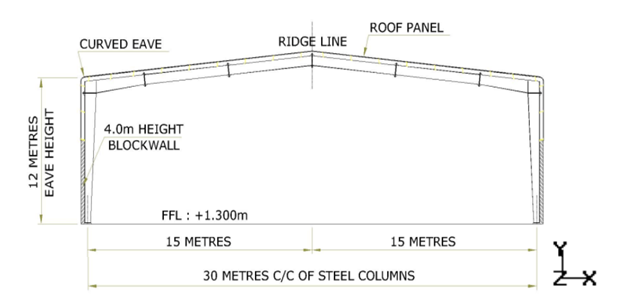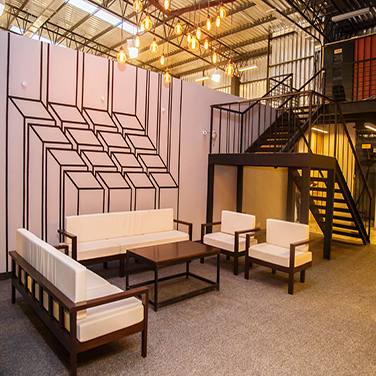The concept of Pre-Engineered Building includes steel building systems which are prefabricated and pre-designed. As suggested by the name, this method requires pre-engineering of structural elements using an existing archive of building materials and manufacturing techniques, providing a wide range of selections to fulfill the structural and aesthetic design requirements. The BMD (Bending Moment Diagram) of the sections can vary across the length, which in turn results in the adoption of non-prismatic stiff frames with slender elements. This effectively leads to the saving of steel and contributes towards cost reduction. The arrangement of a typical PEB frame is illustrated in Figure 1.

Figure 1: Typical PEB Frame (example acquired from internet)
The basic construction and design requirements stay the same for each case which involve:
- Surveying and site layout
- Excavation
- Soil bearing capacity tests
- Placement of Foundation Reinforcement
- Column Reinforcement
- Shuttering and Concreting
- Foundation bolts erection with the help of base plate
- Plinth Beam Reinforcement and Concreting
- PEB columns erection with Foundation Bolts (Erection procedure is standard for all the projects and it results in faster construction and cost effectiveness)
- Fixing of Purlins
- Placement of Roof Beam and Rafter
- Placement of panels(or any other material for enclosure)
Key Design Factors – Biotech Lab for Fermentation Process:
In most cases, more than 50% of the total construction cost of a laboratory building is due to the engineering systems; therefore close coordination of these systems is imperative in ensuring a flexible and efficiently operating lab facility. The key design factors to consider when evaluating the structural system include:
- Depth of the frame and its effect on the floor to floor clearance.
- The ability of the framing to be synced with the operational requirements of the lab.
- Keeping in mind the potential for future expansion.
- Vibration criteria.
The placement of the main exhaust shafts as well as the horizontal ductwork is very critical in designing a flexible lab. In designing laboratory piping systems, the following details should be considered:
- Flexible design that allows easy renovation and modification.
- Provision of a plumbing system for each laboratory based on the laboratory’s operations.
- Employment of systems that minimize energy usage.
- Accessible location of Shutoff valves.
The primary aim of designers should be to create high performance, low-energy and sustainable laboratories such that:
- The overall environmental impact is reduced.
- Occupant safety is ensured.
- Efficiency of the entire building is optimized on a life-cycle basis.
Warehousing of Agro Chemicals Products:
The design and construction of an agro chemical warehouse should take into consideration possible loss scenarios that may affect employees, the surrounding population, the environment, the warehouse building and business continuity. An agro chemical warehouse facility should preferably be designed by a project team knowledgeable in the hazards presented by the materials stored and the special building features which may be required. Life safety, community exposure, containment features, preservation of property and geological conditions include some of the most important factors that should be considered.
Exits from the warehouse need to be arranged so that a single emergency condition, such as fire or accidental spill, will not block access to all exits. Warehouses should be constructed with provisions made for spill containment and drainage to provide adequate protection to the surrounding property, ground water, surface water and public sewers. When designing a warehouse floor, consideration should be given to:
- Site preparation upon which the warehouse is to be built.
- Grade and type of the concrete.
- The techniques to be used in installing the floor.
- The treatment and preparation of the surface of the floor along with making provisions for its maintenance and repair.
The selection of materials used in the construction of an agro chemical warehouse depend on a variety of factors such as building size and geographic location, material costs, energy efficiency, occupancy, construction codes, insurance criteria, owner’s investment strategy (owned vs. leased building) and building aesthetics.
Warehousing for Fertilizer Products/Fertilizer Impregnation Plant:
The building or area dedicated to fertilizer storage and impregnation should be isolated from offices, residential areas and any bodies of water. The floor of the storage area should be impermeable with provisions for secondary containment, away from plant material and high traffic areas. The floors are to be leveled and dry, devoid of any pot-holes. Fire detection and alarm system should be present. An active temperature control mechanism should be present along with no direct sources of heat. An efficient ventilation system, that helps eject heat and fumes from fire or expelled during decomposition, should be present.
Warehousing for Drip Irrigation Items:
A warehouse for drip irrigation items in most cases requires a single storey steel structure that may or may not have mezzanine floors. The enclosures of the structures may be brick masonry, concrete walls or galvanized metal sheet coverings. The walls are usually designed as non-bearing but it is ensured that they are strong enough to sufficiently withstand lateral forces caused by natural conditions/disasters. The warehouse designing includes designing of the elements contributing to the structural integrity of the structure involves the roof truss, the column and base plates, sag rods, tie rods, purlins, bracings, girders etc.
The building materials used in the construction can be based on a variety of factors such as building size and geographic location, material costs, energy efficiency, occupancy, construction codes, insurance criteria, owner’s investment strategy (owned vs. leased building) and building aesthetics.
References
Bahadure, V., & Prasad, R. (2016). Comparison between design and analysis of various configuration of industrial sheds, IJSDR, 1(7), 208-213.
Bhagatkar, S., Gupta, B., Karta, D., & Shaikh, F. (2015). A study on pre-engineered building – a construction technique, Int. Journal of Engineering Research and Applications, 5(5), 5-9.
Fertiliser storage, Crop Nutrition Fertiliser Handling and Safety.
Goswami, A., & Shende, T. (2018). Pre-engineered building design of an industrial warehouse, International Research Journal of Engineering and Technology (IRJET), 05(06), 1484-1488.
Meera, C. (2013). Pre-engineered building design of an industrial warehouse, International Journal of Engineering Sciences & Emerging Technologies, 5(2), 2231-6604.
Organic liquid fertilizer storage, Eco Green Liquid Fertilizer.
Saranya, S., & Shallini, P. (2019). Comaprison of structural elements of pre-engineered building in two different wind zone area, International Research Journal of Engineering and Technology (IRJET), 06(05), 4784-4790.

